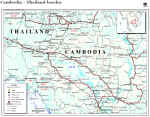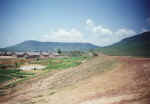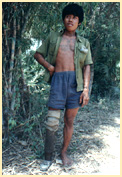Thai / Cambodia Border Refugee
Camps 1975-1999
Information and
Documentation Website
|
|
Khao I Dang / Site II
/ 2 / Site B
/ Site 8 / Sok San / Site K / O'Trao
|
Photos, Maps,
Statistics, People, Places and Events
|
Home - Border Camps
- NGOs - UNBRO - Border
History - Repatriation - Documents
- Maps
- Glossary - Links
- About - Site Map - Contact
The Thai /
Cambodia Border Camps 1975 - 1999
Over
the years there were many camps along the Thai / Cambodian border.
There were 5
significant population movements that created new camps and sometimes
destroyed old camps:
Starting in
1975 with those fleeing the Khmer Rouge when they took power, followed in
1979 by those fleeing starvation and the advancing Vietnamese army,
followed by those affected by the 1984/85 Vietnamese offensive along the
Thai border, followed by those fleeing the 1997 coup by Hun Sen and
finally followed by the remnants of the Khmer Rouge in 1998.
The last
border camp closed in 1999.
|

Thai / Cambodian Border 1997 |
|

Children |

Site II
|

Soldier
Photo by
Erez
Yanuv
|
Thai / Cambodian Border Camps 1975 - 1999
|
| 007 |
Early camp near Nong Samet,
population went to Nong Samet. |
| Ang
Sila |
Circa 1983. Evacuation
site for Nong Chan prior its incorporation into Site II (1986). Received
residents of Nong Chan temporarily during offensives of 1983. |
| Ampil |
Sub-camp of Site 2 and KPNLF military
headquarters in Cambodia - Ban Sangae / Ban
Sa Ngae. |
| Anlong Veng |
KR camp / stronghold, opposite Sisaket province, Thailand. |
| Aranyaprathet |
Aranyaprathet town had a
number of camps. |
| Aranyaprathet camp 15 |
Ban Thai Samart - opened Sept. 1976. |
| Ban
Baranae |
Circa 1984. FUNCINPEC camp,
see Site B. |
| Ban Mamuang |
September 1997 to March 1999, housed refugees
from coup. (United Nations High Commissioner on Refugees
(UNHCR), Vulnerable Groups Survey: Ban Mamuang and Khao Phlu Camps,
Bangkok: UNHCR, 1998) |
| Ban Napho |
Lao border camp - MOI. |
| Ban Nam Yao |
Lao border camp - MOI. |
| Ban Sae Prai |
1998 camp in Phu Sing District, Sisaket.
Refugees from Anlong Veng. Closed March 24, 1999. |
| Ban Sangae / Ban Sa
Ngae |
see Ampil |
| Ban Thad |
UNHCR refugee camp for
Vietnamese, adjacent to Site II. Closed
in 1990. |
| Banthai Samath |
Active in 1987
(opening and closing dates unknown). |
| Ban Vinai |
Lao border camp - MOI. |
| Borai |
UNBRO / KR displaced persons camp in Trat,
Thailand opposite Pursat province in Cambodia. |
| Bung
Beng / Klong Wah |
KR Camp evacuated in 1985 to
Site 8. |
| Camp 85 |
KR camp inside Cambodia - see Phum Doeng. |
| Chakri |
This was not so much a refugee camp as a
‘khum’ (hamlet) of scattered settlements hugging the Thai border.
With a population of at least 10,000 people, it was made up in part by the
former residents of the military camp known as "Khao Din" or
"Site 8 North". |
| Chanmeh |
Circa 1983. Evacuation site
for Nong Chan prior its incorporation into Site II (1986). Received
residents of Nong Chan temporarily during offensives of 1983. |
| Chiang Kham |
Lao border camp - MOI. |
| Chomrom They |
? |
| Chong Bok |
KR camp. |
| Chu Kaki |
A meeting point for the Red Cross to receive war
wounded in Odar Meanchey. The area around Chu Kaki has thousands of
residents, many of whom formerly lived in the camp known as An Kbal Leov. |
| Dang
Rek
|
Sub-camp of Site 2,
established in mid-1983, incorporated into Site 2 in March 1985. |
| David |
Circa 1984. FUNCINPEC camp,
see Site B. |
| Green Hill |
FUNCINPEC camp near to Site B but in Cambodia. |
| Huay Chan |
UNBRO / Khmer Rouge displaced persons camp.
Situated near the border of Sisaket province in Thailand and Preah Vihear in Cambodia. |
| Huay Cherng |
FUNCINPEC camp - 1997
(UNHCR Map) |
| Kab Cherng |
Lao border camp - MOI. |
| Kamput Holding Center |
Processing center for immigration to U.S. -
opened 1979, closed
Dec. 1982. Originally a KR camp, converted to a processing centre, then
closed. |
| Kap Choeng |
Camp in Surin opened in Aug. 1980, ICRC surgical
hospital. |
| Khao
Din |
KR Camp evacuated in 1985 to
Site 8. |
| Khao-I-Dang |
MOI / UNHCR Khmer refugee camp. Opened Nov. 21, 1979. |
| Khao Phlu |
September 1997 to March 1999, housed refugees
from coup. ARC provided medical care. 1998, approximately 12,000 Cambodian
refugees. |
| Klong
Wah / Bung Beng |
KR Camp evacuated in 1985 to
Site 8. |
| Lum Pi Ni |
Transit camp near the
international airport in Bangkok. Circa 1981. Some people were moved through
this camp to Galang camp in Indonesia. |
| Mak Mun |
Population went to Nong
Samet camp. |
| Mairut |
Camp / processing center
(1980 - 81). Originally a KR camp for 2 years it was converted into a
processing centre and the people moved to Khao I dang. It was located
in Trat province 2 km from Mairut village, 40 min. north of Klong Yai. |
| Nam Yuen |
see Nong Chan |
| Nam Yun |
KR camp. |
| Na Trao |
See O'Trao. |
| Nong Chan |
Sub-camp of Site 2,
incorporated into Site 2 in 1986. A KPNLF camp inside
Cambodia. Also known as Nam Yuen. |
| Nong
Pru |
KR Camp evacuated in 1985 to
Site 8. |
| Nong
Samet 1 |
Original Nong Samet camp.
Camp inside Cambodia, destroyed in 1984. |
| Nong Samet |
Sub-camp of Site 2 also
known as Rithysen. Established
in 1979 near Khao I Dang,
incorporated into Site II after its destruction in December 1984. A KPNLF camp inside Cambodia / Red Hill. |
| NW 82 |
Camp for Vietnamese land
refugees opened at Nong Samet Dec. 1981. |
| NW-9 |
Camp opened for Vietnamese who walked across Cambodia -
April 1980 to July 1981. 4.5 miles from Nong Chan. |
| O'Bok |
Sub-camp in Site II. |
| 0 Plerng Chheh |
Known to the Thai as Sop
Tlee, this area may also be regarded as a ‘khum’ of scattered
settlements on the border. |
| O'Smach |
FUNCINPEC camp inside Cambodia, opposite Surin
province, Thailand. |
| O’Sralau |
KR Camp evacuated in 1985 to
Site 8. |
| O'Trao |
UNBRO / Khmer Rouge displaced persons camp.
Situated near the border of Sisaket province in Thailand and Preah Vihear in Cambodia. |
| PARA |
1987? |
| Phanat Nikhom |
Refugee processing center. |
| Phnom Malai |
KR stronghold in Cambodia,
near Aranyaprathet. |
| Phum Doeng |
Known to the Thai as Nong Prue, this khum (
"hamlet") of scattered settlements is in northern Battambang
Province due west of "Poipet Chas". It had a population of at
least 1 0,000 people made up in part by the former residents of the KR
military camp known as "Camp 85" or "Site 8 West". |
| Phum Tmey |
See Site 8. |
| Plerng Chheh |
Known to the Thai as Sop Tlee, this area may
also be regarded as a ‘khum’ of scattered settlements in southern
Battambang Province hugging the Thai border. |
| Red Hill |
Formerly Nong Samet. |
| Rithysen |
See Nong Samet in Site II. |
| Sakeo Holding Center |
Early Khmer refugee camp, opened October 1979.
Near to Sakeo (now the provincial capital), off the road from Aranyaprathet to
Sakeo.
According to eyewitness reports nun by a KR
commander by the name of Prak Lim. "I witness a few "repatriations"
in those days, trucks of young KR fighters leaving the camp at about 11pm
for the border. A lot of the camp inmates resisted these repatriations
and their appeals to the UNHCR man there went unheeded."
|
| Sakaeo II |
Opened July 1980, closed in
1984. |
| Sanro |
Sub-camp in Site II. |
| Site 1 |
Evacuation center in the vicinity of Site II. |
| Site II / Site 2 |
UNBRO / KPNLF displaced persons camp near Taphraya,
Thailand. |
| Site 3 |
Circa 1983. Evacuation site
for Nong Chan prior its incorporation into Site II (1986). Received
residents of Nong Chan temporarily during offensives of 1983. |
| Site 6 |
Circa 1983. Evacuation site
for Nong Chan prior its incorporation into Site II (1986). Received
residents of Nong Chan temporarily during offensives of 1983. |
| Site 8 |
UNBRO / KR displaced persons camp south of
Aranyaprathet, Thailand. Opened early 1985. Also known as Phum Tmey. |
| Site 8 North |
KR camp inside Cambodia, see
Khao
Din. |
| Site 8 West |
KR camp inside Cambodia - see Phum Doeng. |
| Site A |
? |
| Site B |
UNBRO / FUNCINPEC displaced persons camp
80Km from Surin,
Thailand. Also known as Green Hill. Established June
1985. |
| Site E |
See Sok Sann. |
| Site K |
UNBRO / KR displaced persons camp in Trat,
Thailand opposite Pursat province in Cambodia. |
| Sok San |
UNBRO / KPNLF displaced persons camp in Trat,
Thailand opposite Pursat province in Cambodia. Also known as Site
E. |
| Tap
Prik |
KR Camp evacuated in 1985 to
Site 8. |
| Tatum |
A FUNCINPEC camp of a least 20,000 people
situated in Siem Riep province approximately two hours walk from Site B
camp. It was the home for ANS combatant personnel and their families. |
| Ta Luan |
KR camp. |
1989 Border Khmer
Demographic Survey - includes camp descriptions and additional
historical information.
Background
The border camps
with the exception of Khao I Dang were managed by UNBRO (United Nations Border
Relief Operation - under UNDP) and supported by the NGOs that ran the
infrastructure programs.
The border camps
were not recognised as refugee camps, that is, the UNHCR did not
manage them or have any official connection with them. Khao I
Dang was the only UNHCR camp on the border, with its residents enjoying
the rights due refugees, all of the other camps were "Displaced
Persons" camps whose residents were not eligible for asylum, emigration,
nutritional or health standards and rights due a refugee.
The displaced
persons camps were formally under Thai control (JOC/SC), who in turn allowed the
Cambodian resistance factions to control the civilian populations in
each camp. These included the Royalist FUNCINPEC party, KPNLF - Khmer
Peoples National Liberation Front and the Khmer Rouge or DK.
The displaced
persons camps served the purposes of the Thais, China and the West. The Thais
were trying to stop the flood of refugees and destabilize the Vietnam supported
Phnom Penh government. The West also wanted to keep the pressure on both
Vietnam and Cambodia and indirectly on the Soviet Union. China wanted to apply
pressure on Vietnam. They accomplished this by supporting the resistance factions
with arms, training and bases in Thailand. They legitimized their support
by allowing the factions to herd Cambodian civilians into closed border
camps in Thailand and claim them as supporters who needed humanitarian
assistance.
Life in the
Camps
According to Ogata
(head of UNHCR) during a visit to the border in 1991, the Khmer were the
"best cared for refugees in the world"; she added that this was a real
disincentive for them to repatriate and that their services should be cut!
Life in the border
camps was on the whole better than inside Cambodia - food, water, shelter,
healthcare and education, all were consistent in provision and in most cases superior to what
existed in Cambodia. But the population density and
abnormal environment made for an unnatural and stressful existence. Many people came to use
the camps as a backup during times of drought or fighting in Cambodia.
There was the dark
side to the camps with all manner of exploitation and human rights violations
ranging from conscription and forced population movements to extortion and
physical abuse by Thai authorities. Add to this an abundance of war weapons and the
potential for deadly violence multiplies. It was not unusual to hear of grenades
and RPGs being used in personal disputes.
By 1992 the border
camps were nothing short of Cambodian cities in Thailand, despite the efforts of
the Thai government to prevent permanent settlements. One of the Thai rules was
that there should be no permanent structures in the camps. They compromised by
allowing concrete floors for our printing presses and large paper cutting
machines, all other structures were made of bamboo and thatch. Some ingenious
and well off Khmer built concrete bomb shelters to protect their families during
periodic shelling or frequent bandit attacks on the camps.
Programs
After so many years
the infrastructure was impressive, from the water and sanitation to ICRC's
surgical hospital in Khao-I-Dang to the two functioning universities in Site II,
there was little in Cambodia to compare.
Water -
provided
and distributed directly by UNBRO
Sanitation
and Site Maintenance -
CONCERN, IRC (KID)
Health care -
ARC,
IRC, CRS, COERR, COR, CAMA, Handicapped International, UNBRO - pharmacy, surveillance,
Psychiatric hospital - KID
Food -
provided and
distributed directly by UNBRO
Each person on a
family card received food ration (family cards were a constant source of counterfeiting
and multiple registration). Those who worked were paid with an additional rice
ration. Excess rice was sold to Thai traders who sold it back to the suppliers
to UNBRO.
Education -
Primary education -
coordinated by UNBRO, provided by Khmer, IRC (KID)
Secondary Education -
COERR, IRC (KID)
Vocational Training -
COERR, Dom Bosco, IRC
Teacher
Training - IRC - KID
University - COERR, KP
- Site II / 2
Printing - IRC,
JRSC (KID only)
Computer training -
IRC - Taphrya
Special Education - IRC
- Site 2 / II
French
Language - SIPAR - Site II / 2
There were 50,000
children in school using books printed in the camps, the literacy rate far
exceeded that in Cambodia. There was a biweekly Khmer language newspaper.
Social programs -
AA - COERR
- Site 2 / II
Prisoner rehab - COERR
- Site II / 2
Khmer
Fine Arts - IRC - KID
TMC - Traditional
Medicine Clinics - KID
Unaccompanied
Minors - COERR, IRC
LMAP
- Land Mine Awareness Program - IRC - all camps
|
Border
Refugee Population
|
| Year |
Population |
Year |
Population |
| 1975 |
|
1987 |
|
| 1976 |
|
1988 |
|
| 1977 |
|
1989 |
|
| 1978 |
|
1990 |
|
| 1979 |
|
1991 |
|
| 1980 |
|
1992 |
|
| 1981 |
|
1993 |
|
| 1982 |
|
1994 |
|
| 1983 |
|
1995 |
|
| 1984 |
|
1996 |
|
| 1985 |
|
1997 |
57,557
(UNHCR Map) |
| 1986 |
|
1998 |
|
Home - Border Camps
- NGOs - UNBRO - Border
History - Repatriation - Documents
- Maps
- Glossary - Links
- About - Site Map - Contact
Web Services
by

Send mail to with questions or comments about this website.
Last modified: 13/05/14
All photos by Richard
Rowat unless otherwise specified



